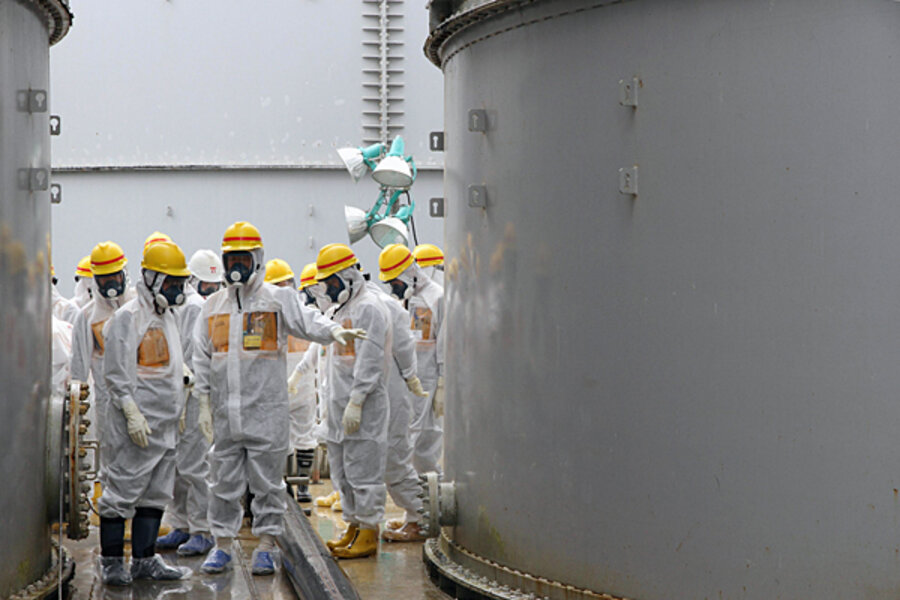New Fukushima leak puts spotlight on plant operator - again
| Osaka, Japan
More than two years after it suffered a triple meltdown, the Fukushima Daiichi nuclear power plant is once more setting off alarm bells around the world as calls mount at home for the cleanup to be taken out of the hands of Tokyo Electric Power (Tepco).
News this week that about 300 tons of highly toxic water had leaked from a storage tank at the plant have provoked anger at home and prompted calls for an international task force to come to the aid of the embattled Japanese utility.
The latest leak, involving one of more than 1,000 tanks that store water after it has been used to cool the tsunami-wrecked reactors, underlined the dangers the plant still poses to the environment and Fukushima residents, and the sheer scale and complexity of the operation to make it safe.
The leak is the single most serious incident at Fukushima Daiichi since the March 11, 2011, earthquake and tsunami knocked out its backup power supply and triggered the world’s worst nuclear accident in a quarter of a century.
Japan’s Nuclear Regulation Authority initially described the leak as a level-1 incident on an eight-point international scale devised by the International Atomic Energy Agency. But a day later, the authority raised the severity to level 3, revising its description of the leak from an “anomaly” to a “serious incident.” The triple meltdown in March 2011 warranted a maximum 7 on the scale, putting it on a par with the Chernobyl disaster in 1986.
Tepco said it was checking 350 other tanks of a similar design for possible seepages and conceded that the leaked water may have polluted the sea.
“The water may have reached the ocean because we measured high radiation doses in a drainage ditch located near the tank that flows into the sea,” a Tepco spokeswoman told the Monitor. “We are taking this incident very seriously.”
The regulation authority’s chairman, Shunichi Tanaka, produced perhaps the most evocative description of the stricken plant.
The possibility of leakages from other tanks "is the biggest concern," Mr. Tanaka told reporters. "I don't know if describing it this way is appropriate, but it's like a haunted house and, as I've said, mishaps keep happening one after the other.
"We must remain alert,” he said. “We should assume that what has happened once could happen again, and prepare for more. We are in a situation where there is no time to waste."
News of the latest crisis has only increased the sense that Tepco is ill equipped to address the plant’s myriad problems. It recently faced accusations of a coverup after belatedly admitting that up to 300 tons of contaminated water into the Pacific Ocean every day. Those leaks, which are separate from the most recent incident, involve the huge quantities of water that is being used to cool fuel inside the damaged reactors.
Culture of denial
Ian Fairlie, a London-based independent consultant on radioactivity in the environment, described the firm’s response as “very grim.”
“Like the Japanese government, Tepco is unable to come to terms with this in the sense that it has a deep and abiding faith in nuclear energy, so this is very troubling for them,” Dr. Fairlie says. “This is a massive loss of face, and that’s difficult for them, too.”
Together, the incidents have refocused attention on deficiencies in Tepco’s approach that became apparent soon after the March 2011 meltdown. Then, the firm was accused of attempting to play down the gravity of the situation, only admitting the true extent of the crisis when scientific evidence made it impossible to suggest otherwise.
Two-and-a-half years later, that culture of denial persists, says Fairlie. “You have to treat anything Tepco says as unreliable – if anything, they’re just describing the tip of the iceberg here. If they say there’s a slight problem, it means there is something serious going on.”
Even Tepco officials appear to have come to the realization that the firm is losing the battle to contain radioactive water.
“We will revamp the management of contaminated water to tackle the issue at Fukushima Daiichi and seek expertise from inside and outside Japan,” said the firm’s vice president, Zengo Aizawa, who described the leaks as a “problem that could lead to a crisis.”
"Many other countries outside of Japan have experienced decommissioning reactors, so we hope we can consult them more and utilize their experience. In that sense, we need support, not only from the Japanese government, but from the international community."
But, according to Fairlie, Japan’s nuclear industry has an abiding antipathy toward accepting help from outsiders.
“Tepco and the government are not in the business of saying, ‘This is serious, come and help us out,’ ” he says. “And this isn’t a question about Tepco’s future – there’s nothing to replace it. There are lots of things going wrong in Fukushima at the moment, and the only people who really know about them work for Tepco.”
With Japan’s two operational reactors at Oi nuclear power plant slated to go offline next month for routine checks, the country will again be without atomic energy for only the second time in almost 50 years.
The recent leaks could prove a major obstacle to Prime Minister Shinzo Abe’s plans to restart more reactors – a move he says is unavoidable to prevent lasting damage to Japan’s economy.
Fallout
Local fisheries, which were forced to suspend indefinitely fishing trials in the area, have taken a huge hit. And now, water contamination is fueling concern among Japan’s neighbors.
China said it was “shocked” to hear about the leaks, and requested more information. “We hope Japan can take effective steps to put an end to the negative impact of the aftereffects of the Fukushima nuclear accident," China's foreign ministry said in a statement.
South Korea, too, has asked for more details, while Asiana Airlines, the country’s second biggest carrier, said it would cancel charter flights between Seoul and Fukushima from October due to public concern over radiation.
Some experts, however, caution against overreacting to the leaks, and defended Tepco’s actions. “Though serious, this leak is a long way from the level seven incident we were facing in 2011,” said Andrew Sherry, director of the Dalton Nuclear Institute at the University of Manchester. “The approach taken by Tepco to drain the tank, pump leaked water to temporary storage, and protect the drainage of contaminated water to ground water, is entirely sensible.”
Tepco’s reform?
And despite mounting criticism of Tepco at home and abroad, there is no indication that its role in the operation to contain toxic water and begin the long and costly process of removing fuel and decommissioning will change.
Tepco was saved from financial collapse in 2012 by the injection of trillions of yen of government money; the consensus is that the troubled utility is considered too big and too close to the Japan’s pro-nuclear government for that to happen.
“It is hard to believe that Tepco will be allowed to fail – that is just not the way things happen in Japan,” says Shaun Burnie, an independent nuclear consultant based in Washington. “Reform of Tepco is more than likely to be superficial … I believe the company will still be around for years to come.”
Mr. Burnie is skeptical, too, about the ability of an international task force to overcome the problems facing Fukushima Daiichi. “The challenges faced by Tepco are as complex as any major nuclear crisis that has occurred in the last six decades," he says. "It is important to understand that no nuclear entity, whether it be utility or government, has managed to contain radioactivity from major accidents.”
While he supports ending Tepco’s day-to-day management of the Fukushima operation, Burnie does not believe that government intervention will prevent future mishaps. “An international team made up solely of industry and department of energy contractors will not prevent major problems from recurring. Nor should they inspire confidence,” he says.
“An international team that includes independent specialists not tied to industry or government would make the most sense, but would be a major challenge in itself. The fuel removal plan should be subjected to independent scrutiny, with all the information on the table, although this is unlikely. The fuel and water problems have been the greatest challenges since the accident, and that will remain the case.”






